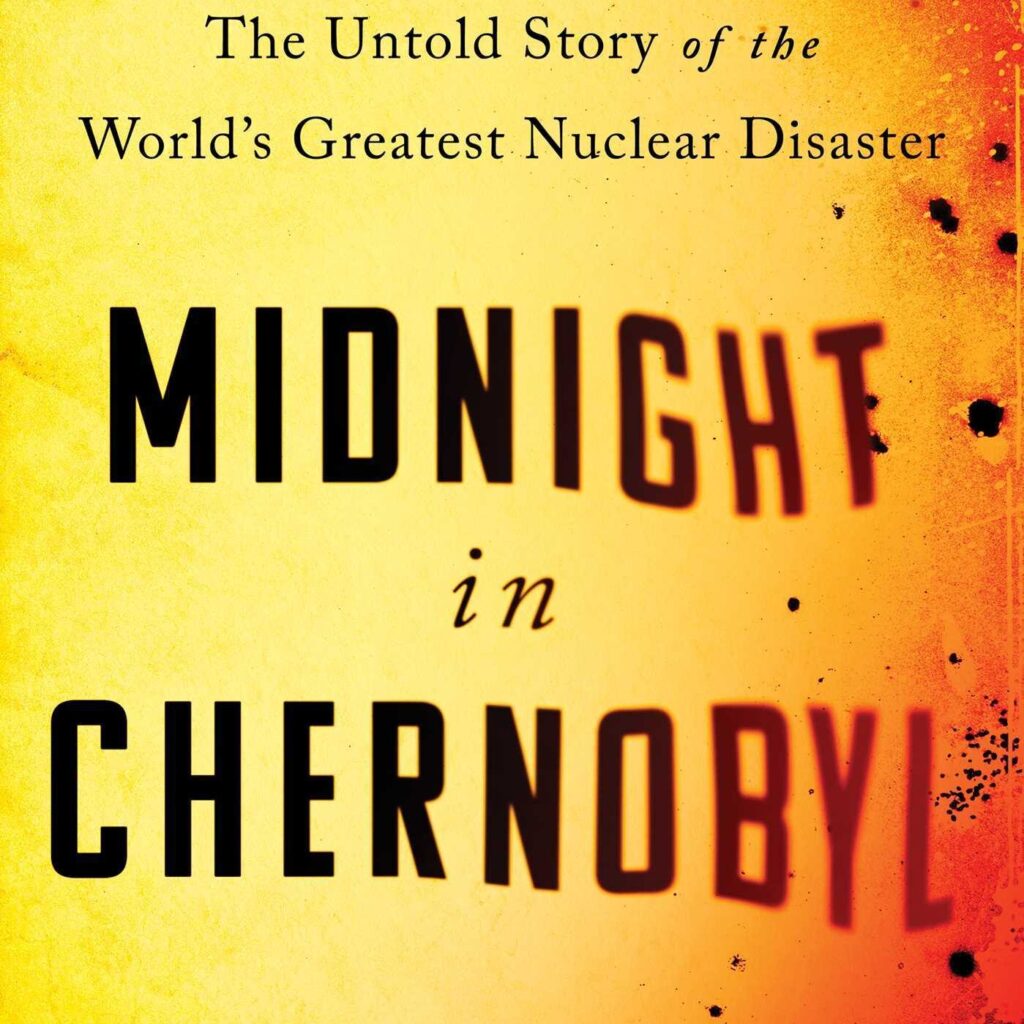
Adam Higginbotham’s Midnight in Chernobyl is an in-depth, meticulously researched account of the Chernobyl nuclear disaster, which took place in April 1986. The book not only details the technical aspects of the explosion but also places it within the broader historical context of the Soviet Union, highlighting the political and social environment that played a significant role in the catastrophe.
The Lead-Up to the Explosion
The story of Chernobyl begins well before the fateful night in April 1986. Higginbotham takes readers back to the inception of nuclear power in the Soviet Union, detailing the ambitions of the USSR to become a superpower through technological advancements, especially nuclear energy. The construction of the Chernobyl Nuclear Power Plant in northern Ukraine was part of this vision, seen as a symbol of Soviet supremacy.
However, beneath this facade of progress and innovation, the system was riddled with flaws. Higginbotham exposes the bureaucratic inefficiencies, political pressures, and the widespread culture of secrecy that plagued Soviet institutions. Engineers and scientists working on Chernobyl were aware of the shortcomings of the RBMK reactor design, particularly its instability at low power, but their concerns were routinely dismissed or suppressed by higher authorities who were more concerned with maintaining their image than addressing potential hazards.
The Night of the Disaster
On the night of April 25-26, 1986, a safety test was scheduled to take place at Reactor No. 4 of the Chernobyl plant. The test, intended to assess how long the reactor could continue to generate power in the event of a blackout, involved shutting off safety systems—a procedure that, in retrospect, seems incredibly reckless.
Higginbotham masterfully reconstructs the events of that night, weaving together the actions of various engineers, technicians, and plant operators. A combination of human error, inadequate training, and flawed reactor design led to a catastrophic explosion, which blew off the reactor’s roof and released massive amounts of radioactive material into the atmosphere. The explosion itself was not immediately understood by those in the control room, who initially assumed a less severe malfunction had occurred. It wasn’t until they ventured outside and saw the reactor core exposed to the sky that the true extent of the disaster became evident.
The Immediate Aftermath
The explosion set off a chain of chaotic events. Initially, Soviet authorities refused to acknowledge the severity of the incident, delaying evacuation and downplaying the risks to both plant workers and local residents. The city of Pripyat, located just a few kilometers from the plant, was not evacuated until 36 hours after the explosion, exposing tens of thousands of people to harmful radiation.
Higginbotham vividly describes the scenes of confusion, fear, and misinformation that followed the explosion. Local firefighters, completely unaware of the radiation danger, were sent to extinguish the fires at the reactor site. Many of these first responders would later succumb to acute radiation sickness.
Internationally, it wasn’t until radiation detectors in Sweden picked up unusually high levels of radiation that the global community became aware of the disaster. Even then, the Soviet government continued to withhold critical information, both from its own citizens and from the world at large.
The Cleanup and Containment
In the days and weeks following the explosion, Soviet authorities scrambled to contain the disaster. The cleanup operation, known as the “liquidation,” involved hundreds of thousands of soldiers, engineers, and civilians, many of whom were exposed to dangerous levels of radiation without adequate protection. Higginbotham tells the stories of these “liquidators,” who were sent to manually clear radioactive debris, bury contaminated equipment, and eventually construct the massive concrete sarcophagus that would encase the destroyed reactor.
The Soviet government, meanwhile, sought to downplay the disaster’s impact, both to the international community and to its own people. Despite the obvious public health risks, the May Day parade in Kyiv—located just 100 kilometers from Chernobyl—went ahead as planned, with children and families celebrating in the streets while radiation levels soared.
Long-Term Consequences
The long-term health effects of the Chernobyl disaster remain a point of contention, as the Soviet Union and later Russian officials downplayed the number of casualties. Higginbotham sheds light on the ongoing debates over the number of deaths directly caused by the explosion and subsequent radiation exposure. Official Soviet reports initially claimed only a few dozen direct deaths, primarily among firefighters and plant workers. However, independent estimates suggest that the true toll, considering long-term radiation-related illnesses such as cancer, could be in the tens of thousands.
The political fallout from Chernobyl was profound. It is widely believed that the disaster played a key role in exposing the weaknesses of the Soviet system, contributing to the eventual collapse of the USSR just a few years later. Higginbotham argues that the Chernobyl incident revealed the rot within the Soviet bureaucratic machine, a system more concerned with maintaining control and covering up failures than addressing the needs of its people.
Impact on the Global Nuclear Industry
Beyond the borders of the Soviet Union, Chernobyl had a lasting impact on the global perception of nuclear energy. The disaster intensified opposition to nuclear power in many countries, prompting a reevaluation of safety standards and regulatory frameworks. Higginbotham details how the incident led to the establishment of new international agreements and safety measures, such as the formation of the World Association of Nuclear Operators (WANO), which aims to improve the safety and reliability of nuclear power plants worldwide.
However, despite these advancements, the shadow of Chernobyl continues to loom over the nuclear industry. Higginbotham highlights the ongoing tensions between the promise of nuclear energy as a clean, efficient power source and the inherent dangers posed by human error, technological failures, and political mismanagement.
Higginbotham’s Narrative Style
What sets Midnight in Chernobyl apart from other accounts of the disaster is its engaging, almost novelistic style. Higginbotham weaves together the personal stories of the individuals involved—scientists, engineers, plant workers, government officials, and ordinary citizens—giving readers a sense of the human cost of the disaster. The book is as much about the people caught up in the tragedy as it is about the technical and political aspects of the event.
Higginbotham’s meticulous research, which draws on previously classified documents, interviews with survivors, and a wide range of sources, ensures that Midnight in Chernobyl is both authoritative and compelling. His ability to balance technical detail with personal narratives makes the book accessible to a broad audience, from those with little knowledge of nuclear energy to experts in the field.
The Cultural Legacy of Chernobyl
Higginbotham also explores the cultural legacy of Chernobyl, which has left an indelible mark on global consciousness. The abandoned city of Pripyat, once a thriving community, has become a symbol of the disaster. Its ghostly, decaying buildings serve as a reminder of the lives that were irrevocably changed by the explosion. The HBO miniseries Chernobyl (2019), which dramatized the disaster, brought renewed attention to the event and its aftermath, prompting new discussions about the dangers of nuclear power and the human cost of governmental secrecy and incompetence.
In the years since the disaster, Chernobyl has become a site of “dark tourism,” with thousands of visitors traveling to the exclusion zone each year to witness the aftermath of the explosion firsthand. Higginbotham reflects on the ethical implications of this phenomenon, questioning whether the desire to visit such places risks trivializing the suffering of those affected.
The Final Verdict
Midnight in Chernobyl is a sobering and comprehensive account of one of the worst nuclear disasters in history. Higginbotham’s detailed exploration of the events leading up to, during, and after the Chernobyl explosion exposes the systemic flaws of the Soviet regime and the far-reaching consequences of the disaster. His emphasis on the human stories behind the catastrophe ensures that readers understand not just the technical aspects, but also the profound human impact of the event.
The book stands as a stark reminder of the dangers of unchecked power, bureaucratic inefficiency, and the devastating consequences of secrecy and denial. As the world continues to grapple with the challenges of nuclear energy, Midnight in Chernobyl serves as both a cautionary tale and a call to action.
Review
Midnight in Chernobyl has garnered widespread acclaim for its thorough research, gripping narrative style, and balanced approach to one of the most significant disasters of the 20th century. Readers have praised Higginbotham for his ability to blend technical details with compelling personal stories, making the book accessible to both experts and laypeople alike. The book’s depth of research, which includes newly declassified documents and interviews with those directly affected by the disaster, sets it apart from previous accounts of Chernobyl. Critics have lauded Higginbotham’s balanced portrayal of the Soviet system, acknowledging both its technological achievements and its glaring flaws.
Some readers have pointed out that the level of detail in the book may be overwhelming for those unfamiliar with the subject, but most agree that the comprehensive nature of the book is one of its greatest strengths. Overall, Midnight in Chernobyl is considered a definitive account of the disaster and a must-read for anyone interested in the history of nuclear energy, the Cold War, or the Soviet Union.
Read the Full Nove l Here
About the Author
Adam Higginbotham is an award-winning journalist and author whose work has appeared in major publications such as The New Yorker, The New York Times Magazine, GQ, and Smithsonian. He specializes in narrative non-fiction, often focusing on historical events with significant global impact. Midnight in Chernobyl is his first book, and it has been widely recognized
for its rigorous research and compelling storytelling. Higginbotham spent over a decade researching and writing the book, drawing on a wealth of sources to provide a comprehensive account of the Chernobyl disaster. His work continues to shed light on pivotal moments in history, offering readers a deep understanding of the complex forces that shape the world.
Explore Related Ebook Novel
- Boneshaker: A Steampunk Adventure {EBook summary}
- The Terminal Experiment: A Journey into the Unknown
- Heating Up the Pages: A Look at Leora Gonzales’ Steamy Romance “Taming Flame”
- Unveiling Humanity’s Layers: A Look at Shirley Hazzard’s “People in Glass Houses”
- Read The Diary of a Young Girl by Anne Frank

